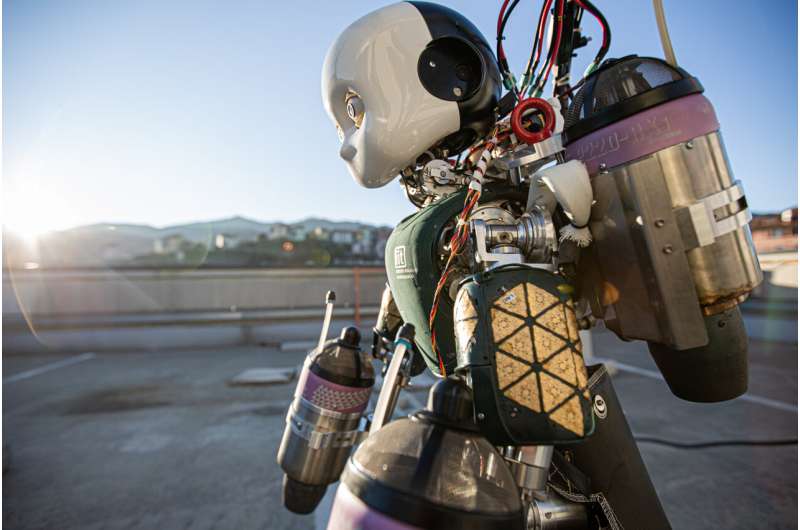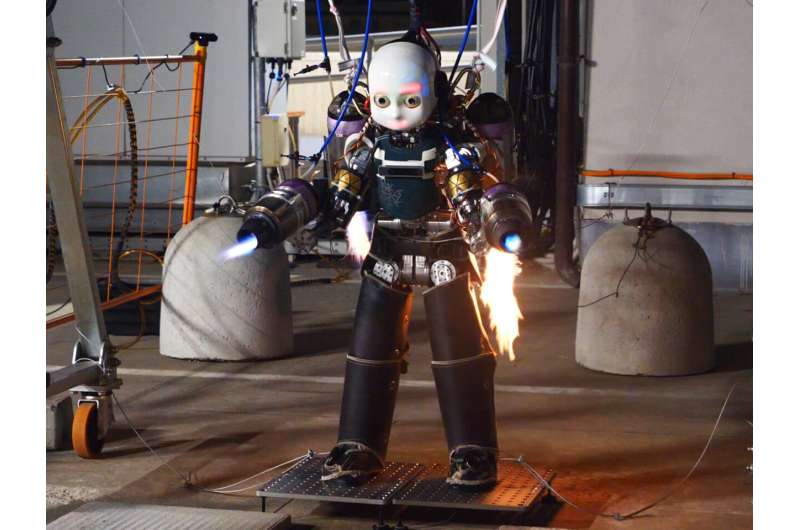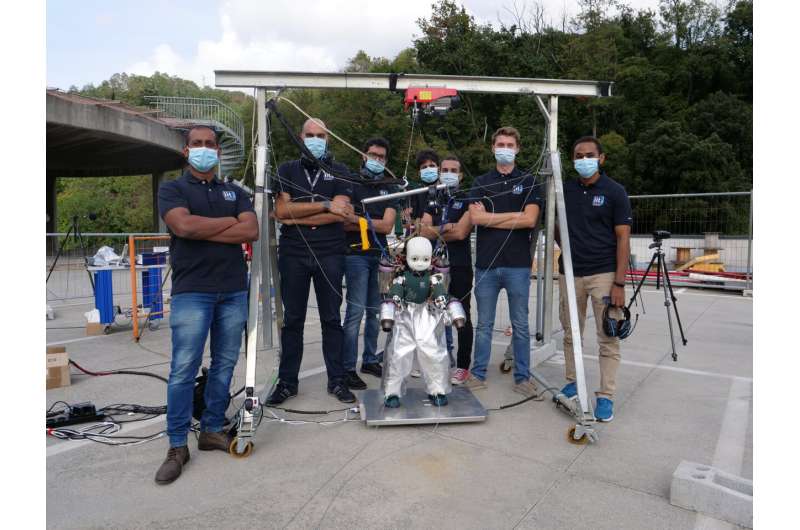December 21, 2021 feature
Moving toward the first flying humanoid robot

Researchers at the Italian Institute of Technology (IIT) have recently been exploring a fascinating idea, that of creating humanoid robots that can fly. To efficiently control the movements of flying robots, objects or vehicles, however, researchers require systems that can reliably estimate the intensity of the thrust produced by propellers, which allow them to move through the air.
As thrust forces are difficult to measure directly, they are usually estimated based on data collected by onboard sensors. The team at IIT recently introduced a new framework that can estimate thrust intensities of flying multibody systems that are not equipped with thrust-measuring sensors. This framework, presented in a paper published in IEEE Robotics and Automation Letters, could ultimately help them to realize their envisioned flying humanoid robot.
"Our early ideas of making a flying humanoid robot came up around 2016," Daniele Pucci, head of the Artificial and Mechanical Intelligence lab that carried out the study, told TechXplore. "The main purpose was to conceive robots that could operate in disaster-like scenarios, where there are survivors to rescue inside partially destroyed buildings, and these buildings are difficult to reach because of potential floods and fire around them."
The key objective of the recent work by Pucci and his colleagues was to devise a robot that can manipulate objects, walk on the ground and fly. As many humanoid robots can both manipulate objects and move on the ground, the team decided to extend the capabilities of a humanoid robot to include flight; rather than developing an entirely new robotic structure.
"Once provided with flight abilities, humanoid robots could fly from one building to another avoiding debris, fire and floods," Pucci said. "After landing, they could manipulate objects to open doors and close gas valves, or walk inside buildings for indoor inspection, for instance looking for survivors of a fire or natural disaster."
Initially, Pucci and his colleagues tried to provide iCub, a renowned humanoid robot created at IIT, with the ability to balance its body on the ground, for instance standing on a single foot. Once they achieved this, they started working on broadening the robot's locomotion skills, so that it could also fly and move in the air. The team refer to the area of research they have been focusing on as 'aerial humanoid robotics."
"To the best of our knowledge, we produced the first work about flying humanoid robots," Pucci said. "That paper was obviously testing flight controllers in simulation environments only, but given the promising outcomes, we embarked upon the journey of designing iRonCub, the first jet-powered humanoid robot presented in our latest paper."
The thrust estimation framework created by the researchers significantly simplifies their flying robot's design and reduces its cost of fabrication, as it does not require the installation of force sensors on each of the jet engines propelling the robot. Instead of estimating thrust using force sensor data, the framework combines two different sources of information into a single estimation process.

The first source of information used by the framework is derived by a model that relates commands sent to the jet engine with the resulting thrust. This is a data-driven model that was trained on data collected by the researchers.
"We first built an ad-hoc experimental setup that much looks like a fireproof and bulletproof chamber where to place jet-engines and run experiments safely," Pucci said. "Then, by using this setup, we collected input/output data from the jet engine and selected the models that describe how the engine behaves. To do this, we built on one of our previous works."
The second source of information used by the team's framework to estimate thrust is the so-called 'centroidal momentum' of the whole robot. This is a renowned value used by roboticists developing humanoid systems to control and estimate their movements.
"When used properly, for instance, this value can characterize the motions of a diver jumping off a cliff," Pucci said. "In other words, it can be used to relate the causes (i.e., thrust forces) and the effects (e.g., vertical accelerations for take-off) of the robot motion before and after take-off."

If they were to be used individually, both the information sources used by the team's framework would have significant limitations. For instance, the data-driven model they used would only be able to accurately estimate thrust if a jet engine was always performing in the exact same way. However, jet engines can perform differently based on various different environmental factors.
"The second approach, on the other hand, does not use internal jet information," Pucci said. "So, we used Kalman Filtering to combine both approaches to overcome their individual drawbacks. Notably, our estimation approach is independent from the specific nature of flying humanoid robots and can be used in flight controllers designed for any flying multibody robot."
To evaluate the effectiveness of their framework, Pucci and his colleagues tested it on a newly developed robot called iRonCub, an evolution of the iCub robot with integrated jet engines. While the team has been working on this robot for a while, they were only recently able to demonstrate its full set of features.
"Dealing with jet-powered robots is not an easy task, since jet air temperature may reach 700 degrees Celsius and air speed may have supersonic features, flowing at about 1800 km/h," Pucci explained. "For this reason, we developed strict experimental procedures and protocols that allow us to work with iRonCub safely. In this respect, our research team had to overcome several problems and issues that are far from those associated with classical robotics research and closer to those of avionics."
While the researchers have so far only tested the thrust estimation framework on their humanoid robot iRonCub, it could also be applied to other flying robots with different body structures. This includes reconfigurable flying robots, systems that can change shape or configuration to perform specific actions.
"The problem of estimating thrust forces is pivotal for a successful flight in any case," Pucci said. "Furthermore, besides the futuristic application of flying humanoid robots in disaster-like scenario, we believe that our work can be applied to simpler designs than flying humanoid robots, including jet-powered flying boxes."
If applied to jet-powered flying boxes, the thrust estimation framework developed by the researchers could open new opportunities for the delivery of various products in remote locations, including food and pharmaceutical drugs. If they receive funding from the E.U. or scientific foundations, Pucci and his colleagues would like to explore this possible application more in depth.
Meanwhile, the team plans to continue working on iRonCub, focusing on its flight capabilities. Their hope is to eventually present the first reliable and highly performing humanoid robot capable of both terrestrial and aerial locomotion.
"In our lab, we have several research teams that tackle different topics related to humanoid robotics," Pucci said. "The iRonCub team is focusing on long-term, mid-term and short-term research directions in Aerial Humanoid Robotics. For the long-term, two researchers in our team, Antonello Paolino and Fabio Di Natale, are investigating computational fluid dynamics models for the robot aerodynamics to be integrated into the iRonCub flight control. Fabio Bergonti, on the other hand, will focus on integrating these models into control architectures of futuristic flying humanoid robots that adapt their shape according to the surrounding aerodynamics, as if the robot were a transformer."
As a mid-term research objective, two of Pucci's colleagues, Affaf Momin and Hosameldin Awadalla, plan to improve the thrust estimation framework they created using artificial intelligence (AI) and data-driven computational tools. Subsequently, their colleague Giuseppe L'Erario will focus on integrating these algorithms into controllers that unify a robot's walking, manipulation, running, take-off, and horizontal flight strategies.
"Finally, as a short-term objective, Punith Reddy will be focusing on making the iRonCub untethered," Pucci added. "At the experimental level, our iRonCub scrum master Gabriele Nava is focusing on taking care of all integration activities for the first successful iRonCub flight, consisting in a vertical take-off and landing. This latter short-term plan is very challenging, but I believe that we have enough knowledge and will to achieve this important milestone, sooner or later."
More information: Hosameldin Awadalla Omer Mohamed et al, Momentum-Based Extended Kalman Filter for Thrust Estimation on Flying Multibody Robots, IEEE Robotics and Automation Letters (2021). DOI: 10.1109/LRA.2021.3129258
Daniele Pucci et al, Momentum Control of an Underactuated Flying Humanoid Robot, IEEE Robotics and Automation Letters (2017). DOI: 10.1109/LRA.2017.2734245
Giuseppe L'Erario et al, Modeling, Identification and Control of Model Jet Engines for Jet Powered Robotics, IEEE Robotics and Automation Letters (2020). DOI: 10.1109/LRA.2020.2970572
© 2021 Science X Network
















